| Article ID | Journal | Published Year | Pages | File Type |
|---|---|---|---|---|
| 5149571 | Journal of Power Sources | 2017 | 12 Pages |
Abstract
In this work, the Ni-Co spinel oxides are synthesized via different methods and using different calcination temperatures. Properties of the prepared materials are compared. The best route is selected and used to prepare a Ni1+xCo2âxO4 (â1 â¤Â x â¤Â 1) series of materials in order to investigate their catalytic activity towards the oxygen evolution reaction (OER). The results show that hydroxide preparation yields NiCo2O4 oxide with the highest activity. 325 °C is identified as the optimum calcination temperature. Subsequently, the catalysts are tested in an electrolysis cell. To prepare an anode catalyst layer based on NiCo2O4 catalyst on top of a nickel foam substrate for membrane electrode assembly (MEA) construction, following polymer binders are used: anion-selective quaternized polyphenylene oxide (qPPO), inert polytetrafluoroethylene (PTFE®), and cation-selective Nafion®. qPPO ionomer containing MEA exhibited highest OER activity. The current density obtained using a MEA containing qPPO binder attains a value of 135 mA cmâ2 at a cell voltage of 1.85 V. After 7 h chronopotentiometric experiment at a constant current density of 225 mA cmâ2, the MEA employing PTFE® binder shows higher stability than the other binders in alkaline water electrolysis at 50 °C. Under similar conditions, stability of the PTFE®-binding MEA is examined for 135 h.
Related Topics
Physical Sciences and Engineering
Chemistry
Electrochemistry
Authors
Debabrata Chanda, Jaromir Hnát, Tomas Bystron, Martin Paidar, Karel Bouzek,
